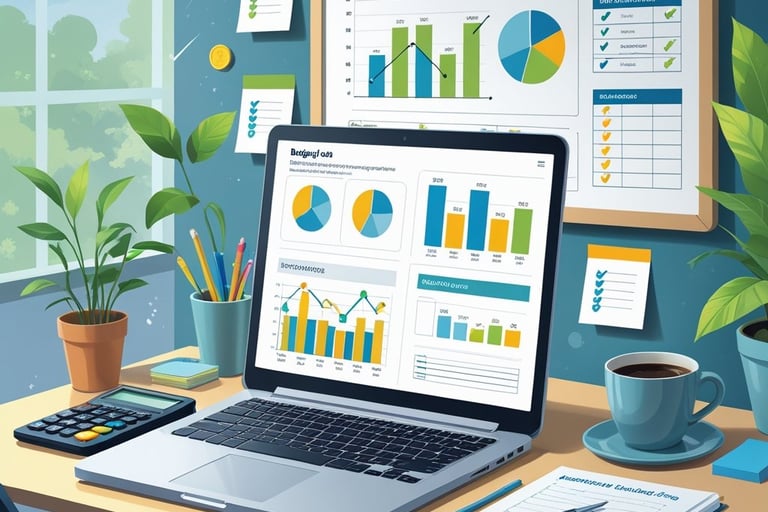10 Budgeting Tips That Actually Work for Beginners: Your Practical Guide
With the right budgeting tips, even beginners can take charge of their money, stress less, and start saving for what really matters.
7/1/20257 min read
Managing money can be overwhelming for those just starting out, but building a solid financial foundation begins with smart and simple budgeting strategies. By following practical budgeting tips proven to work, beginners can take control of their money, reduce financial stress, and start saving for what matters most.
Many people struggle to keep track of expenses or distinguish between needs and wants, leading to overspending and unpredictable balances. This post lays out 10 clear steps that make budgeting manageable and effective, using methods and advice tailored to individuals who are new to handling personal finances.
These straightforward tips are designed to be actionable, realistic, and easy to implement, so anyone can start improving their financial situation without complicated tools or prior experience.
Assess Your Current Financial Situation
Understanding personal finance starts with a clear picture of all income sources, monthly expenses, and patterns in spending. A thorough assessment helps highlight where money is coming from, where it is going, and areas that may need adjustment before setting any budgeting goals.
Calculate Your Total and Net Income
An individual should begin with calculating their total income by listing every source, such as salary, freelance pay, side jobs, rental income, or government benefits. For most people, total income includes more than just their base wage.
Net income is what remains after taxes and deductions. It is the amount actually available to spend or save each month. Reviewing recent pay stubs, bank deposits, or income statements can help confirm this figure.
Making a simple table can clarify the difference between gross and net income:
Income Source Gross (Before Tax) Net (After Tax) Regular Salary $3,000 $2,400 Freelance Project $500 $400 Total $3,500 $2,800
Knowing net income helps prevent overestimating what is truly available for spending and saving, setting the stage for a realistic budget.
Identify and Categorize Monthly Expenses
The next step is to track and categorize all monthly expenses. Expenses generally fall into two types:
Fixed expenses: payments that stay the same each month, such as rent or mortgage, car payments, subscriptions, or insurance premiums.
Variable expenses: costs that fluctuate, like groceries, utilities, fuel, entertainment, or clothing.
A detailed breakdown can reveal necessary expenses versus discretionary spending. It’s helpful to use a spreadsheet or budgeting app for this task, listing each item and amount spent over the past month.
Grouping expenses into categories (e.g., housing, transportation, food, personal care) shows how much is allocated to essentials versus wants. This transparency makes it easier to spot areas where spending might be reduced.
Review and Understand Spending Habits
After income and expenses are clearly outlined, reviewing spending habits is crucial. This involves looking at regular patterns—such as frequent dining out, automatic payments, or impulse purchases—that might not align with financial goals.
Checking past bank statements and receipts for at least a month can reveal small, recurring costs that add up over time. Identifying these habits allows someone to decide which behaviors to continue, adjust, or eliminate.
It is important to note both consistent expenses and one-time or occasional costs, as these can sometimes be overlooked but significantly affect personal finance. Recognizing these trends provides a roadmap for change, supporting more informed financial decisions going forward.
Set Effective Financial Goals
Effective financial goals guide spending, saving, and debt strategies, ensuring actions tie directly to what matters most. Careful goal setting prevents wasted effort and helps track real progress, whether someone is aiming to build an emergency fund, pay off credit card debt, or boost retirement savings.
Establish SMART and Realistic Goals
SMART financial goals are Specific, Measurable, Achievable, Relevant, and Time-bound. Applying this framework turns vague hopes into actionable plans. For example, rather than stating, "Save more money," someone might set a goal to "Save $2,000 for an emergency fund in 12 months."
A table can clarify the process:
SMART Criteria Example Specific Save for emergency fund Measurable $2,000 Achievable Based on monthly budget Relevant Builds financial security Time-bound 12 months
Sticking with realistic targets is important. Goals should stretch an individual but remain within reach, depending on their income and expenses. Adjust plans if progress stalls; flexibility helps prevent discouragement and increases the likelihood of success.
Differentiate Short-Term and Long-Term Objectives
Short-term and long-term financial goals serve different purposes. Short-term goals, like paying off credit card debt or creating a $500 emergency fund, typically span under one year. These boost confidence by demonstrating quick wins and build habits needed for future planning.
Long-term goals look several years into the future. They often include saving for retirement, building home equity, or achieving financial freedom. Balancing both types is key. Individuals might use a list or spreadsheet to separate short-term and long-term objectives and assign realistic time frames to each.
Prioritizing urgent short-term targets helps stabilize finances, while sustained efforts on long-term goals prepare for major life events and security.
Prioritize Savings and Debt Repayment
Allocating resources to both savings and debt repayment accelerates progress toward financial stability. It's essential to distinguish high-interest debt, such as credit card balances, from lower-interest obligations. Focusing on high-interest debt first—the "avalanche" method—reduces cost over time.
Savings should not be neglected. Even small, automatic monthly transfers to an emergency fund or future retirement accounts add up. Consider an approach like the 50/30/20 rule: 50% of income for needs, 30% for wants, 20% split between savings and debt repayment.
This balanced approach helps avoid setbacks, builds financial resilience, and maintains motivation for both short-term and long-term aims.
Build a Practical Budget Plan
A practical budget helps beginners monitor where their money goes each month, set priorities, and support long-term financial management. Choosing effective budgeting techniques and using digital tools can make expense tracking straightforward and maintainable.
Choose the Right Budgeting Method
Selecting a suitable budgeting method lays the foundation for a successful budget plan. Beginners often find the envelope system, simple spreadsheets, or category-based tracking to be the most approachable. Manual methods, such as writing down expenses or using printable templates, offer visibility but may require more effort each week.
Digital solutions, including apps and automated tracking tools, can significantly reduce the workload. Many users appreciate category-based systems because they clearly define where each dollar is allocated. When getting started, individuals should focus on a method they feel comfortable updating and reviewing regularly.
Key considerations for choosing a method:
Personal preference: analog vs. digital
Level of detail: broad categories vs. line-item tracking
Ease of review: how often it will be updated
Switching methods is common, and finding the right fit may take time.
Apply the 50/30/20 Rule or Zero-Based Budget
The 50/30/20 rule divides income into three main categories: 50% for needs, 30% for wants, and 20% for savings and debt repayment. This popular budgeting technique is easy to set up and helps users understand how to balance essentials, discretionary spending, and long-term goals.
For those seeking more precise control, zero-based budgeting (ZBB) assigns every dollar a specific purpose until the monthly budget equals zero. In ZBB, each income dollar is planned for spending, saving, or debt until nothing remains unaccounted for at month’s end. This method suits those willing to track every transaction and adjust promptly as circumstances change.
The best choice depends on personal discipline and how detailed someone wants their budget plan to be. Both strategies help curb overspending and can be revisited monthly as financial needs evolve.
Use Budgeting Apps and Tools
Budgeting apps streamline expense tracking and make sticking to a budget plan much easier. Popular tools like You Need a Budget (YNAB), PocketGuard, and others sync with bank accounts to record purchases automatically. This minimizes manual data entry and enables quick, up-to-date financial management.
Many apps categorize spending, track progress toward budget goals, and send alerts when users near limits. Features such as reports, spending trends, and reminders keep users informed. Budgeting apps can also help beginners stick to techniques like the 50/30/20 rule or zero-based budgeting by automating calculations.
When choosing an app, individuals should consider data security, cost, and feature set. Free and paid options are available, so it's worth comparing them to find the best match. Digital tools can make budgeting less stressful and improve long-term financial habits.
Take Action: Save, Spend, and Adjust Wisely
Effective money management requires clear action steps to protect savings, curb unnecessary expenses, and monitor financial health. Applying structured habits to saving, spending, and regular adjustments is key to building a stable foundation and controlling financial outcomes.
Automate Savings and Use High-Yield Accounts
Setting up automated transfers is a practical way to build savings consistently. By scheduling a portion of income to transfer into savings as soon as a paycheck arrives, individuals are less likely to spend what they intend to save.
High-yield savings accounts offer significantly better interest rates than traditional accounts. Over time, this helps money grow faster without any extra effort. Most reputable banks and credit unions provide high-yield accounts—look for accounts with no or low fees.
Using automatic deposits in combination with a high-yield account creates a set-and-forget strategy that removes human error and promotes steady growth. Even saving small amounts regularly can add up, especially when combined with interest from a high-yield account.
Build and Maintain an Emergency Fund
An emergency fund acts as a safety net for unexpected expenses such as car repairs, medical bills, or sudden job loss. Financial experts typically recommend saving at least three to six months’ worth of essential expenses.
To build this fund, start by setting a modest milestone—such as $500 or $1,000. Use separate accounts to keep emergency savings apart from daily spending money. This reduces the temptation to dip into these funds for non-urgent purchases.
Regular contributions, no matter how small, are important. Use automatic transfers for this purpose. Only access the emergency fund for true emergencies, not routine or discretionary expenses. Maintaining this habit is critical to protecting long-term financial health and stability.
Control Discretionary and Unnecessary Expenses
Tracking discretionary spending helps identify impulse purchases and unnecessary expenses that can erode savings. Discretionary spending includes eating out, subscriptions, entertainment, and other non-essential items.
Create a monthly limit for discretionary spending categories and enforce it strictly. For example, use cash envelopes or set category-specific limits on debit or credit cards to prevent overspending.
Review statements each month for unused subscriptions or memberships. Cancel what is no longer valuable. Keep impulse buying in check by waiting 24 hours before making non-essential purchases. This simple method filters out most unnecessary spending and supports intentional money management.
Track Progress and Adjust the Budget Regularly
Regularly reviewing financial activity is necessary to spot issues and make informed adjustments. Use tools like spreadsheets, budgeting apps, or online banking dashboards to monitor spending against set budgets.
Create a simple table to compare planned and actual expenses each month:
Category Planned Amount Actual Amount Difference Groceries $300 $285 +$15 Entertainment $100 $120 -$20 Transportation $150 $145 +$5
Look for trends in overspending or unexpected savings. Adjust each category as needed, especially when circumstances change, such as losing income or taking on new bills. This ensures every dollar is allocated intentionally and supports strong financial health over time.





